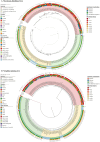Emerging antifungal resistance in Trichophyton mentagrophytes: insights from susceptibility profiling and genetic mutation analysis
- PMID: 39749731
- PMCID: PMC11740296
- DOI: 10.1080/22221751.2025.2450026
Emerging antifungal resistance in Trichophyton mentagrophytes: insights from susceptibility profiling and genetic mutation analysis
Abstract
ABSTRACTTrichophyton species, the leading cause of dermatophytosis globally, are increasingly resistant to antifungal treatments, concerns about effective management strategies. In light of the absence of established resistance criteria for terbinafine and azoles, coupled with a dearth of research on resistance mechanisms in Trichophyton, antifungal susceptibility and drug resistance gene diversity were analyzed across 64 T. mentagrophytes, 65 T. interdigitale, and 2 T. indotineae isolates collected in China between 1999 and 2024 and 101 published T. indotineae strains. Analyses of the minimum inhibitory concentrations (MICs) of terbinafine, itraconazole, voriconazole, posaconazole, and isavuconazole revealed a concerning increase in T. indotineae with terbinafine resistance, including two novel isolates from China. Compared with T. interdigitale, T. mentagrophytes presented higher terbinafine MICs but similar azole susceptibility. Notably, 27 T. interdigitale isolates were classified as non-wild-type for terbinafine. Genetic diversity was analyzed for the SQLE, CYP51A and CYP51B gene. Specifically, T. indotineae isolates presented SQLE protein changes linked to terbinafine resistance. SQLE diversity was linked to terbinafine sensitivity, whereas alterations in CYP51A were associated with itraconazole sensitivity, with notable statistical significance evident across various protein isoforms. The relationship between protein diversity and drug sensitivity is presented in detail. Together, these findings highlight a growing prevalence of antibiotic resistance among Trichophyton and identify potential target genes for new therapies, underscoring the need for ongoing monitoring and offering directions for novel therapeutics.
Keywords: CYP51A/B; SQLE; Trichophyton mentagrophytes complex; antifungal susceptibility; terbinafine.
Conflict of interest statement
No potential conflict of interest was reported by the author(s).
Figures






Similar articles
-
First Reported Cases of Terbinafine-Resistant Trichophyton indotineae Isolates in Israel: Epidemiology, Clinical Characteristics and Response to Treatment.Mycoses. 2024 Nov;67(11):e13812. doi: 10.1111/myc.13812. Mycoses. 2024. PMID: 39547945
-
Detection of terbinafine-resistant Trichophyton indotineae isolates within the Trichophyton mentagrophytes species complex isolated from patients in Hue City, Vietnam: A comprehensive analysis.Med Mycol. 2024 Aug 2;62(8):myae088. doi: 10.1093/mmy/myae088. Med Mycol. 2024. PMID: 39174488
-
Evaluation of DermaGenius® resistance real-time polymerase chain reaction for rapid detection of terbinafine-resistant Trichophyton species.Mycoses. 2021 Jul;64(7):721-726. doi: 10.1111/myc.13271. Epub 2021 May 18. Mycoses. 2021. PMID: 33760310
-
Antifungal resistance in dermatophytes - review of the epidemiology, diagnostic challenges and treatment strategies for managing Trichophyton indotineae infections.Expert Rev Anti Infect Ther. 2024 Sep;22(9):739-751. doi: 10.1080/14787210.2024.2390629. Epub 2024 Aug 18. Expert Rev Anti Infect Ther. 2024. PMID: 39114868 Review.
-
The Emerging Terbinafine-Resistant Trichophyton Epidemic: What Is the Role of Antifungal Susceptibility Testing?Dermatology. 2022;238(1):60-79. doi: 10.1159/000515290. Epub 2021 May 31. Dermatology. 2022. PMID: 34058736 Review.
Cited by
-
Terbinafine Resistance in Trichophyton rubrum and Trichophyton indotineae: A Literature Review.Antibiotics (Basel). 2025 May 7;14(5):472. doi: 10.3390/antibiotics14050472. Antibiotics (Basel). 2025. PMID: 40426539 Free PMC article. Review.
-
[Trichophyton mentagrophytes ITS genotype VIII/Trichophyton indotineae in Germany-revisit after 5 years].Dermatologie (Heidelb). 2025 Aug 12. doi: 10.1007/s00105-025-05553-6. Online ahead of print. Dermatologie (Heidelb). 2025. PMID: 40796670 German.
-
In vitro susceptibility profiles of 16 antifungal drugs against Trichophyton indotineae.Microbiol Spectr. 2025 Aug 5;13(8):e0061825. doi: 10.1128/spectrum.00618-25. Epub 2025 Jun 23. Microbiol Spectr. 2025. PMID: 40548712 Free PMC article.
-
Genomic epidemiology and antifungal resistance of emerging Trichophyton indotineae in China.Emerg Microbes Infect. 2025 Dec;14(1):2498571. doi: 10.1080/22221751.2025.2498571. Epub 2025 May 12. Emerg Microbes Infect. 2025. PMID: 40293476 Free PMC article.
References
-
- Ngo TMC, Santona A, Nu T, et al. . Detection of terbinafine-resistant Trichophyton indotineae isolates within the Trichophyton mentagrophytes species complex isolated from patients in Hue City, Vietnam: A comprehensive analysis. Med Mycol. 2024 Aug 2;62(8):myae088. doi:10.1093/mmy/myae088 - DOI - PubMed
-
- Chanyachailert P, Leeyaphan C, Bunyaratavej S.. Cutaneous fungal infections caused by dermatophytes and non-dermatophytes: an updated comprehensive review of epidemiology, clinical presentations, and diagnostic testing. J Fungi (Basel). 2023 Jun 14;9(6):669. doi:10.3390/jof9060669 - DOI - PMC - PubMed
MeSH terms
Substances
Supplementary concepts
LinkOut - more resources
Full Text Sources
Other Literature Sources
Medical
